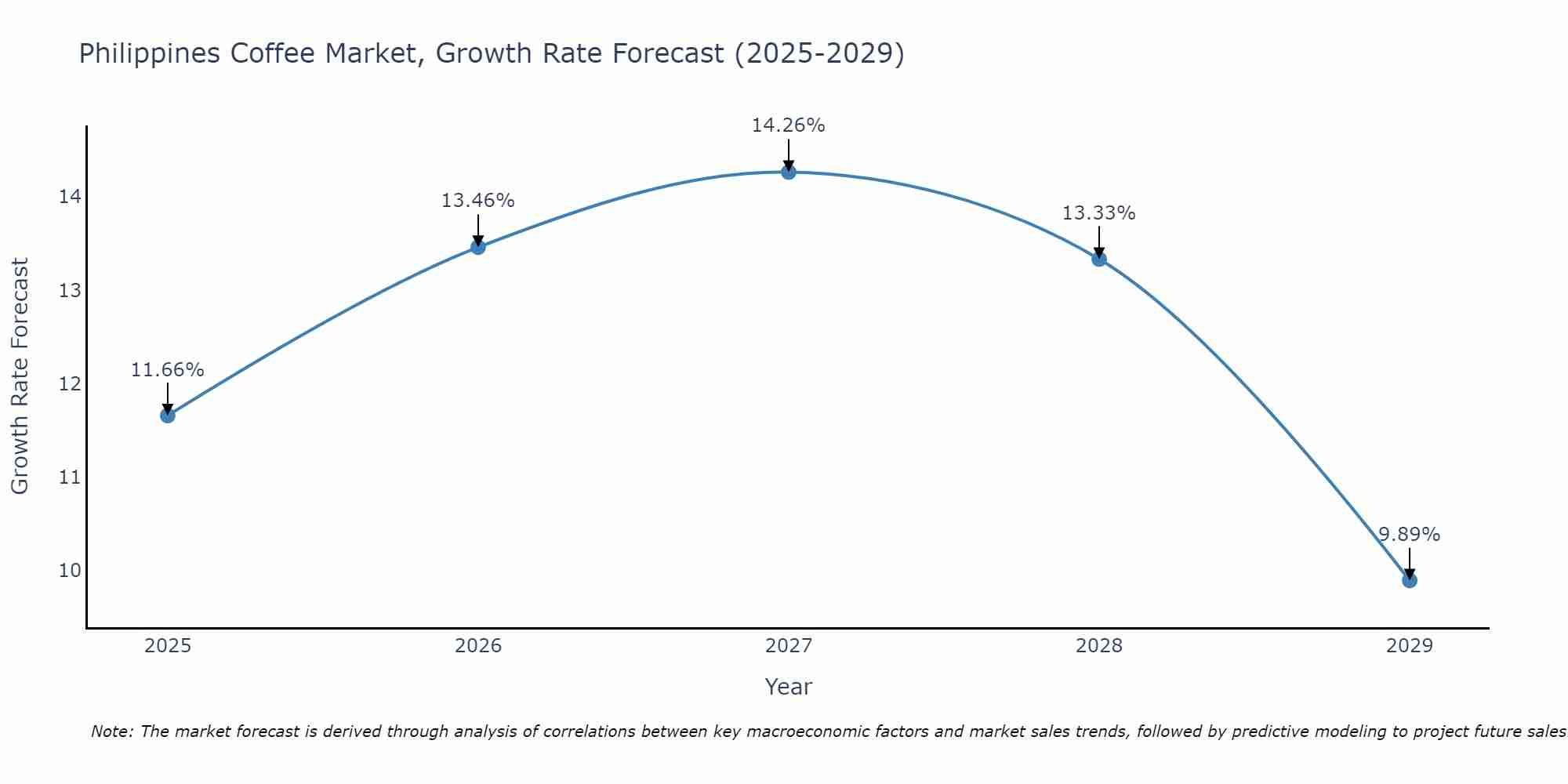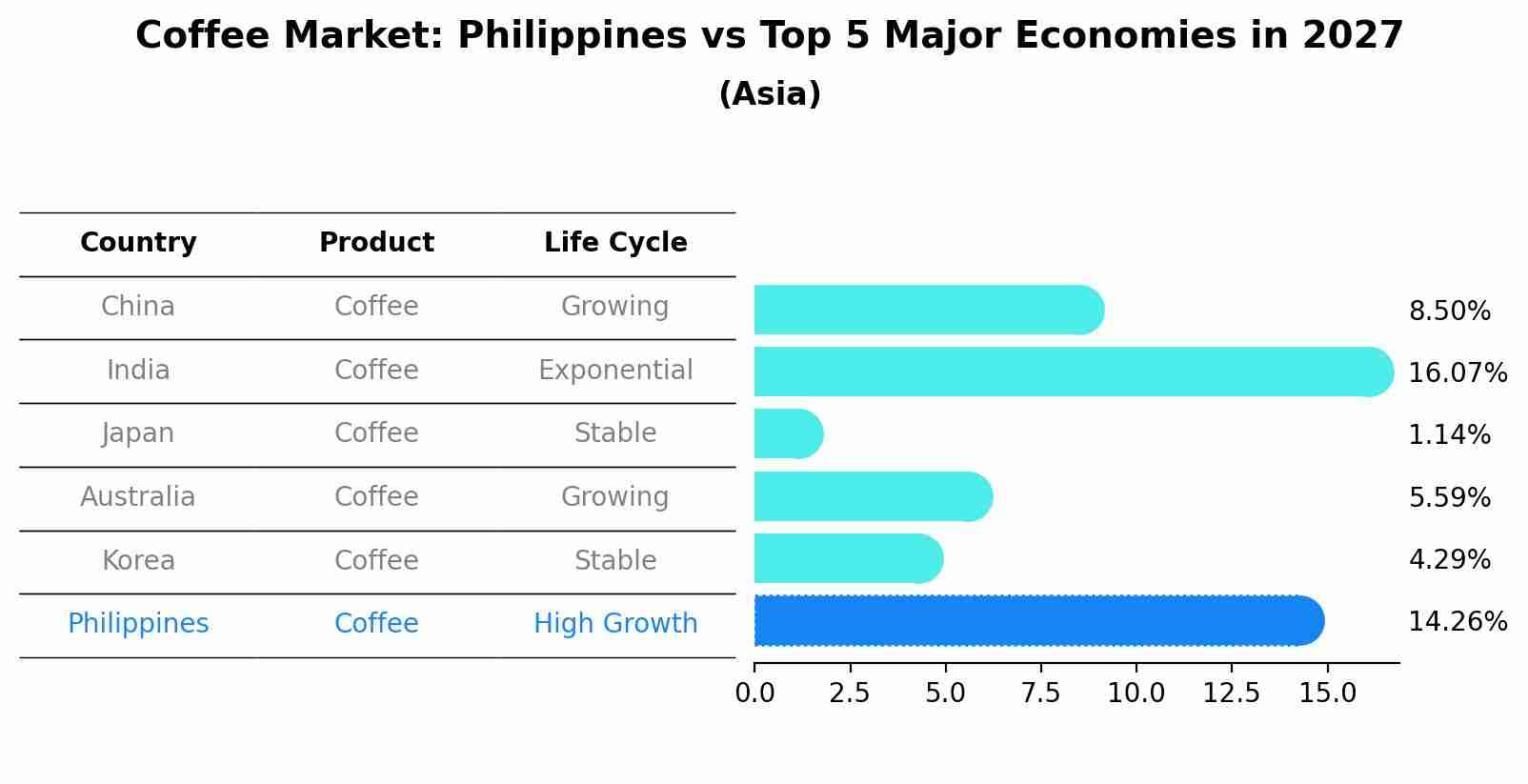Philippines Coffee Market | Growth, Share, Revenue, Industry, Size, Analysis, Trends, Value, Companies, COVID-19 IMPACT & Forecast
| Product Code: ETC177468 | Publication Date: Jan 2022 | Updated Date: Aug 2025 | Product Type: Market Research Report | |
| Publisher: 6Wresearch | Author: Ravi Bhandari | No. of Pages: 70 | No. of Figures: 35 | No. of Tables: 5 |
Philippines Coffee Market Size Growth Rate
The Philippines Coffee Market is projected to witness mixed growth rate patterns during 2025 to 2029. Growth accelerates to 14.26% in 2027, following an initial rate of 11.66%, before easing to 9.89% at the end of the period.

Coffee Market: Philippines vs Top 5 Major Economies in 2027 (Asia)
The Coffee market in Philippines is projected to grow at a high growth rate of 14.26% by 2027, highlighting the country's increasing focus on advanced technologies within the Asia region, where China holds the dominant position, followed closely by India, Japan, Australia and South Korea, shaping overall regional demand.

Philippines Coffee Market Synopsis
The Philippine coffee market was estimated to be worth around US$ 363 million in 2020 and is expected to grow at an impressive rate during the forecast period, exhibiting a CAGR of 6%. This can be attributed to changing lifestyles, increased disposable incomes levels coupled with active promotional activities undertaken by leading players operating within this sector. In addition, increasing trend towards specialty coffees has resulted in surging demand for Arabicas and robusta beans from various regions across Southeast Asia Pacific region including Indonesia and Vietnam. Moreover, innovations pertaining to packaging materials used along with flavored blends offered by prominent brands are also likely influence the overall industry outlook positively over next few years.
Drivers of the market
The Philippines coffee market thrives due to the enduring popularity of coffee as a beverage that offers both sensory enjoyment and a potential energy boost. Coffee culture, the availability of diverse coffee types, and the emergence of specialty coffee shops contribute to the market`s growth. The market is driven by the social aspects of coffee consumption and its integral role in daily routines.
Challenges of the market
Key challenges in the Philippines coffee market included the closure of coffee shops, reduced demand for out-of-home consumption, and supply chain disruptions. The lockdowns and restrictions impacted coffee imports, roasting, and distribution, posing challenges for both domestic and international coffee players.
Covid-19 Impact of the market
The Philippines coffee market witnessed a series of transformative changes during the COVID-19 pandemic. With the closure of cafes and a significant reduction in foot traffic, the traditional coffee shop culture was disrupted. As a result, the demand for coffee products shifted from out-of-home consumption to home brewing. Key players in the coffee market had to rapidly adapt by focusing on retail distribution, introducing innovative coffee products suitable for home use, and enhancing their online presence to cater to consumers` evolving preferences. Supply chain disruptions affected coffee bean sourcing and logistics, leading to challenges in maintaining product availability. However, through creative solutions, companies navigated these obstacles and found opportunities in providing consumers with quality coffee experiences in the comfort of their homes.
Key Players of the market
Prominent players in the Philippines coffee market are influential in producing, processing, and distributing coffee beans to meet the demands of coffee lovers. Companies like CoffeeHarvest Farms, RoastMasters Inc., and NutriCoffee Producers play a pivotal role in supplying coffee that is enjoyed in various forms and preparations.
Key Highlights of the Report:
- Philippines Coffee Market Outlook
- Market Size of Philippines Coffee Market, 2023
- Forecast of Philippines Coffee Market, 2030
- Historical Data and Forecast of Philippines Coffee Revenues & Volume for the Period 2020-2030
- Philippines Coffee Market Trend Evolution
- Philippines Coffee Market Drivers and Challenges
- Philippines Coffee Price Trends
- Philippines Coffee Porter's Five Forces
- Philippines Coffee Industry Life Cycle
- Historical Data and Forecast of Philippines Coffee Market Revenues & Volume By Product Type for the Period 2020-2030
- Historical Data and Forecast of Philippines Coffee Market Revenues & Volume By Whole-Bean for the Period 2020-2030
- Historical Data and Forecast of Philippines Coffee Market Revenues & Volume By Ground Coffee for the Period 2020-2030
- Historical Data and Forecast of Philippines Coffee Market Revenues & Volume By Instant Coffee for the Period 2020-2030
- Historical Data and Forecast of Philippines Coffee Market Revenues & Volume By Coffee Pods and Capsules for the Period 2020-2030
- Historical Data and Forecast of Philippines Coffee Market Revenues & Volume By Distribution Channel for the Period 2020-2030
- Historical Data and Forecast of Philippines Coffee Market Revenues & Volume By On-Trade for the Period 2020-2030
- Historical Data and Forecast of Philippines Coffee Market Revenues & Volume By Off-Trade for the Period 2020-2030
- Philippines Coffee Import Export Trade Statistics
- Market Opportunity Assessment By Product Type
- Market Opportunity Assessment By Distribution Channel
- Philippines Coffee Top Companies Market Share
- Philippines Coffee Competitive Benchmarking By Technical and Operational Parameters
- Philippines Coffee Company Profiles
- Philippines Coffee Key Strategic Recommendations
Frequently Asked Questions About the Market Study (FAQs):
1 Executive Summary |
2 Introduction |
2.1 Key Highlights of the Report |
2.2 Report Description |
2.3 Market Scope & Segmentation |
2.4 Research Methodology |
2.5 Assumptions |
3 Philippines Coffee Market Overview |
3.1 Philippines Country Macro Economic Indicators |
3.2 Philippines Coffee Market Revenues & Volume, 2020 & 2030F |
3.3 Philippines Coffee Market - Industry Life Cycle |
3.4 Philippines Coffee Market - Porter's Five Forces |
3.5 Philippines Coffee Market Revenues & Volume Share, By Product Type, 2020 & 2030F |
3.6 Philippines Coffee Market Revenues & Volume Share, By Distribution Channel, 2020 & 2030F |
4 Philippines Coffee Market Dynamics |
4.1 Impact Analysis |
4.2 Market Drivers |
4.2.1 Increasing coffee consumption among the younger population in the Philippines |
4.2.2 Growing trend of specialty coffee shops and cafes in urban areas |
4.2.3 Rising awareness about the health benefits of coffee consumption |
4.3 Market Restraints |
4.3.1 Fluctuating coffee prices in the global market affecting local pricing |
4.3.2 Limited availability of high-quality coffee beans locally |
4.3.3 Competition from other beverages like tea and energy drinks |
5 Philippines Coffee Market Trends |
6 Philippines Coffee Market, By Types |
6.1 Philippines Coffee Market, By Product Type |
6.1.1 Overview and Analysis |
6.1.2 Philippines Coffee Market Revenues & Volume, By Product Type, 2020-2030F |
6.1.3 Philippines Coffee Market Revenues & Volume, By Whole-Bean, 2020-2030F |
6.1.4 Philippines Coffee Market Revenues & Volume, By Ground Coffee, 2020-2030F |
6.1.5 Philippines Coffee Market Revenues & Volume, By Instant Coffee, 2020-2030F |
6.1.6 Philippines Coffee Market Revenues & Volume, By Coffee Pods and Capsules, 2020-2030F |
6.2 Philippines Coffee Market, By Distribution Channel |
6.2.1 Overview and Analysis |
6.2.2 Philippines Coffee Market Revenues & Volume, By On-Trade, 2020-2030F |
6.2.3 Philippines Coffee Market Revenues & Volume, By Off-Trade, 2020-2030F |
7 Philippines Coffee Market Import-Export Trade Statistics |
7.1 Philippines Coffee Market Export to Major Countries |
7.2 Philippines Coffee Market Imports from Major Countries |
8 Philippines Coffee Market Key Performance Indicators |
8.1 Number of new coffee shops opening in urban areas |
8.2 Percentage increase in per capita coffee consumption |
8.3 Growth in demand for premium and specialty coffee blends |
8.4 Adoption rate of sustainable and ethical coffee sourcing practices |
8.5 Number of coffee-related events and festivals in the Philippines |
9 Philippines Coffee Market - Opportunity Assessment |
9.1 Philippines Coffee Market Opportunity Assessment, By Product Type, 2020 & 2030F |
9.2 Philippines Coffee Market Opportunity Assessment, By Distribution Channel, 2020 & 2030F |
10 Philippines Coffee Market - Competitive Landscape |
10.1 Philippines Coffee Market Revenue Share, By Companies, 2023 |
10.2 Philippines Coffee Market Competitive Benchmarking, By Operating and Technical Parameters |
11 Company Profiles |
12 Recommendations |
13 Disclaimer |
- Single User License$ 1,995
- Department License$ 2,400
- Site License$ 3,120
- Global License$ 3,795
Search
Thought Leadership and Analyst Meet
Our Clients
Related Reports
- Canada Oil and Gas Market (2026-2032) | Share, Segmentation, Value, Industry, Trends, Forecast, Analysis, Size & Revenue, Growth, Competitive Landscape, Outlook, Companies
- Germany Breakfast Food Market (2026-2032) | Industry, Share, Growth, Size, Companies, Value, Analysis, Revenue, Trends, Forecast & Outlook
- Australia Briquette Market (2025-2031) | Growth, Size, Revenue, Forecast, Analysis, Trends, Value, Share, Industry & Companies
- Vietnam System Integrator Market (2025-2031) | Size, Companies, Analysis, Industry, Value, Forecast, Growth, Trends, Revenue & Share
- ASEAN and Thailand Brain Health Supplements Market (2025-2031) | Strategy, Consumer Insights, Analysis, Investment Trends, Opportunities, Growth, Size, Share, Industry, Revenue, Segments, Value, Segmentation, Supply, Forecast, Restraints, Outlook, Competition, Drivers, Trends, Demand, Pricing Analysis, Competitive, Strategic Insights, Companies, Challenges
- ASEAN Bearings Market (2025-2031) | Strategy, Consumer Insights, Analysis, Investment Trends, Opportunities, Growth, Size, Share, Industry, Revenue, Segments, Value, Segmentation, Supply, Forecast, Restraints, Outlook, Competition, Drivers, Trends, Demand, Pricing Analysis, Competitive, Strategic Insights, Companies, Challenges
- Europe Flooring Market (2025-2031) | Outlook, Share, Industry, Trends, Forecast, Companies, Revenue, Size, Analysis, Growth & Value
- Saudi Arabia Manlift Market (2025-2031) | Outlook, Size, Growth, Trends, Companies, Industry, Revenue, Value, Share, Forecast & Analysis
- Uganda Excavator, Crane, and Wheel Loaders Market (2025-2031) | Strategy, Consumer Insights, Analysis, Investment Trends, Opportunities, Growth, Size, Share, Industry, Revenue, Segments, Value, Segmentation, Supply, Forecast, Restraints, Outlook, Competition, Drivers, Trends, Demand, Pricing Analysis, Competitive, Strategic Insights, Companies, Challenges
- Rwanda Excavator, Crane, and Wheel Loaders Market (2025-2031) | Strategy, Consumer Insights, Analysis, Investment Trends, Opportunities, Growth, Size, Share, Industry, Revenue, Segments, Value, Segmentation, Supply, Forecast, Restraints, Outlook, Competition, Drivers, Trends, Demand, Pricing Analysis, Competitive, Strategic Insights, Companies, Challenges
Industry Events and Analyst Meet
Whitepaper
- Middle East & Africa Commercial Security Market Click here to view more.
- Middle East & Africa Fire Safety Systems & Equipment Market Click here to view more.
- GCC Drone Market Click here to view more.
- Middle East Lighting Fixture Market Click here to view more.
- GCC Physical & Perimeter Security Market Click here to view more.
6WResearch In News
- Doha a strategic location for EV manufacturing hub: IPA Qatar
- Demand for luxury TVs surging in the GCC, says Samsung
- Empowering Growth: The Thriving Journey of Bangladesh’s Cable Industry
- Demand for luxury TVs surging in the GCC, says Samsung
- Video call with a traditional healer? Once unthinkable, it’s now common in South Africa
- Intelligent Buildings To Smooth GCC’s Path To Net Zero


















